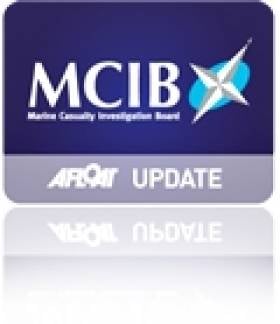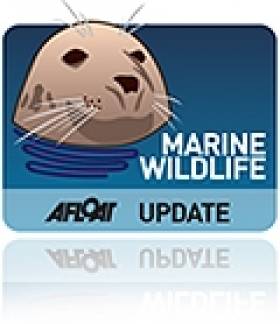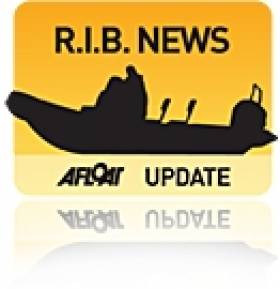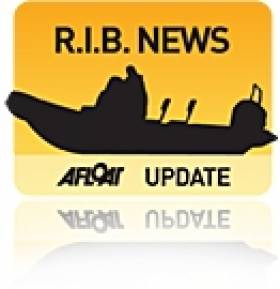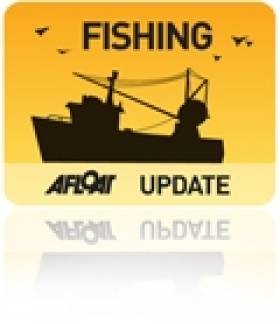Displaying items by tag: Rib
First Dublin Bay RIB Raid from Dun Laoghaire to Greystones
#RIB – The National Yacht Club is running Dublin Bay's first Rib Raid from Dun Laoghaire on the south side of the bay to the new harbour in Greystones in Co. Wicklow on Sunday 5th May.
The raid is in aid of the RNLI and it is open to all ribs & small motorcraft.
The plans are for the RIb fleet to assemble in the pool at the National Yacht Club at 10.00. There is a costume theme of Pirates of the Muglins plus a voluntary RNLI safety check and briefing.
There will be an 11.30 departure from Dun Laoghaire and plan for lunch at Greystones – ashore or onboard before heading home and a BBQ at National Yacht Club.
There are prizes for the best dressed pirates, a navigation challenge.
Man Lost Arm After Going Overboard from RIB In Cork Harbour
#MCIB - A man who lost his arm when he fell overboard from his boat in Cork Harbour last summer could have avoided the accident if he had followed essential safety precautions, according to the official report into the incident. The full report is available to download below as a PDF document.
Owen Corkery of Carrigaline was the subject of a 'miracle rescue' on 9 June 2012 when he was thrown overboard from his RIB, which subsequently struck him several times after he entered the water near Haulbowline Island, causing serious injuries to his head, back and left arm.
As previously reported on Afloat.ie, the RNLI said Corkery was "incredibly lucky to have been spotted from the shore" by a man now known to be Paul Bryans, who had been looking through a telescope at Fort Camden in Crosshaven approximately a mile away from the site of the incident.
Bryans and colleague Dick Gibson immediately raised the alarm with the emergency services and Crosshaven RNLI respectively, and rescue crews were dispatched within minutes.
While the lifeboat volunteers took control of the wayward RIB, Corkery was quickly retrieved from the water by the crew of the Cork Harbour Pilot boat Sonia. They found him incoherent and bleeding heavily, and also noted that while he was wearing a working personal flotation device (PFD), he was not wearing warm clothes or shoes.
Corkery was transferred via ambulance to Cork University Hospital, where his left arm was later amputated just above the elbow due to the severity of his injuries.
According to the official report into the incident by the Marine Casualty Investigation Board (MCIB), the RIB was found to be undamaged but had no CE or other approval mark.
The kill cord on the boat's motor was also found to be malfunctioning, as the engine could be started whether or not it was attached, and did not shut off when removed.
The report states that Corkery - an experienced powerboat user who had not completed any recognised handling course - has since explained he was aware of the kill cord malfunction but continued to use the vessel.
He confirmed in the same interview with investigators that he was standing beside the helm of the RIB at the time of the incident, a position that "would have made him considerably more likely to be thrown from the vessel".
Investigators also found it likely that Corkery's lack of shoes would also have reduced his grip while standing on the floor of the RIB.
In its conclusions, the MCIB report - which is available to download below - emphasises that the kill cord is an "essential part of safety equipment for all open motorboats" that should always be used and checked regularly, and that the helm of any high-speed watercraft should always remain seated, even at low speeds.
It also recommends that all pleasure craft owners should complete a recognised powerboat handling course.
Donegal Shark Prank Not So Funny After All
#MarineWildlife - Recent hijinks by a group of Irish surfers in 'shark-infested waters' off Donegal have been making the rounds online - but they're not all what they seem.
IrishCentral reports on the video, apparently posted by surfers from Rossnowlagh, which shows the group on a RIB pushing one of their own overboard into the path of an oncoming shark.
Yet despite their reactions, they were never in any danger, as the shark was one of Ireland's harmless giants - a basking shark - who clearly attempts to dodge the dinghy as it approaches.
Indeed, the shark may even have been in more danger from the surfers than they were from it, as the marine species is designated as protected under EU law, which makes it illegal to disturb or harass them.
As reported on Afloat.ie earlier this year, the UK's Shark Trust has published a code of conduct for anyone encountering basking sharks in British or Irish waters - and pushing someone overboard on top of one is definitely absent from the list.
Garda Boat Taken in Daylight Robbery
#BOAT THEFT - A boat owned by the Garda Sub-Aqua Club worth €25,000 was last week stolen in broad daylight, as the Evening Herald reports.
Smooth criminals removed the Tornado RIB from its mooring at Coal Harbour in Dun Laoghaire and loaded onto a trailer on Friday afternoon.
The "brazen" theft went unnoticed till gardaí arrived at the mooring later that evening.
The top-of-the-range boat, used by the sub-aqua club for diving training, is fitted with VHF radios and specialist GPS equipment.
A source told the Herald that the thieves "were very calm and professional in how they removed the boat and left without being in any kind of panic."
The Evening Herald has more on the story HERE.
Ballycotton Lifeboat Assists Broken Down RIB
#rnli – The annual family fun day was held on Ballycotton pier to raise funds for Ballycotton lifeboat yesterday on bank holiday Sunday afternoon. At 12:30 the lifeboat station received a call from a rib with engine failure east of Ballycotton lighthouse and requesting assistance. The lifeboat crew abandoned their posts on Ballycotton pier and proceeded to the all weather lifeboat moored in the harbour. The Ballycotton lifeboat, Austin Lidbury, proceeded east of the lighthouse and reached the rib with four persons on board. The pleasure craft was taken under tow to Ballycotton harbour, where they were closely observed by visitors on the pier attending the fundraising activities.
The afternoon was a hit with the many visitors being able to observe a live rescue. Among the afternoon's activities was "Rock the Boat" which took place at 3:00pm, with in excess of 100 people taking part to fulfil a condition of a sponsor who offered €100 if 100 people or more took part. A short video clip of this is available to view on the Ballycotton Lifeboat website www.ballycottonlifeboat.org. At 3:45pm the Waterford based Coast Guard helicopter did a fly-by over the pier. Conditions were not suitable to demonstrate a lift of a person from the Ballycotton lifeboat which was going through manoeuvres in Ballycotton Bay.
At 5pm the visitors moved from the pier to the village to continue the fundraising activities with a wet t-shirt competition in the Blackbird. The event rounded up a weekend of fundraising events for the Ballycotton RNLI lifeboat, which included a football competition on Thursday evening, a table quiz in the Schooner Bar on Friday and a family treasure hunt and Pitch "n" Putt competition on bank holiday Saturday. The organisers and volunteer crew appreciated the support they received during the long weekend of fundraising events from both sponsors and supporters.
#RIB – Do you want to get a front seat to watch the V70's in Galway? Do you have a Rigid Inlatable Boat (RIB) and want to launch in the City and be sure of a berth for it in the docks? Well, there's only one way to be certain of all these and that's to volunteer yourself and your RIB as a Marshall boat. RIBs must be 5.5 metres in length or bigger and volunteers would need to be available for Thursday 4th to Saturday 7th July.
Contact the On Water Manager at Let's Do It Global email [email protected] or telephone the Volvo Race Office 091539995. Or visit the website and fill in volunteer form and include your RIB details.
Sligo RIB Specialists Move to Larger Premises
#RIBs – One of Ireland's largest Rib and Inflatable Boat Service Centres is on the move.
With almost 20 years experience Inland Inflatable Service run by Ronan and Sinead Keys is moving to a new purpose built 8000 sq foot Rib Repair Centre in Collooney, Co Sligo.
The firm also stocks a large selection of new and used Yamaha and Honda outboard engines.
Safety Advice for Leisure Boaters in MCIB's Helvick Head Report
#MCIB - The Marine Casualty Investigation Board (MCIB) has called for better safety awareness among leisure boat users in its report into the deaths of two men off Helvick Head in Co Waterford in May 2010.
John O'Brien and Pat Esmonde were lost overboard from their small RIB on 23 May 2010, and their remains were recovered two days later. Post-mortems confirmed that both died by drowning.
The report does not conclude exactly how the incident occurred. But accounts from eyewitnesses who sighted the men in the minutes before state that neither was wearing a lifejacket, despite the legal requirement to do so - and despite O'Brien having no seafaring experience and Esmonde being unable to swim, as confirmed by their families.
The MCIB also noted that while there were two lifejackets aboard the vessel, they were for emergencies and not suitable for constant wear as per the requirements for the vessel class.
Other safety issues highlighted include the kill-cord on the engine, which was not being used, and the fact that the initial distress call was made by mobile phone and not VHF radio.
Though neither had any bearing on this specific incident, the MCIB warned in particular that mobile phone calls are closed in nature, whereas VHF distress calls can be heard and answered by any vessel in the vicinity.
The board recommends that the Minister for Transport "undertakes a highly visible information poster campaign on piers and launching areas relating to lifejackets, VHF radio and emergency contact details" and also reminds boaters of their legal obligations.
The full report is available to download as a PDF from the MCIB website HERE.
Massive Irish 16-Metre RIB Nears Completion at Red Bay
#RIBS–Antrim's Red Bay Boats are building a 16-metre RIB and the new model to the Red Bay range will have a number of commercial applications. The Northern Ireland boat firm is operating at full capacity with commercial orders this month, a tonic for these times, and the firm headed by Tom McLaughlin, will be exhibiting a full range at the UK Seaworks Boat Show in late May.
With the hull mold of the the new 16-metre craft completed, the first Redbay Stormforce 1650 is underway! The boat is going to be built as a Pilot Boat and will be used for demo's and will be on display at the upcoming boat shows.
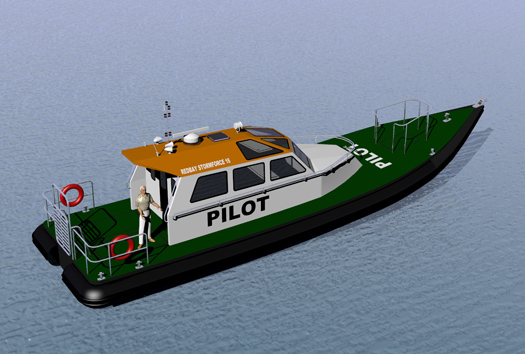
The impressive 16m design is now under construction at Cushendall in County Antrim
The photos below show the first hull being laid with fibreglass. Beside the hull mold is the plug for the deck mold and the cabin mold which are still being made.
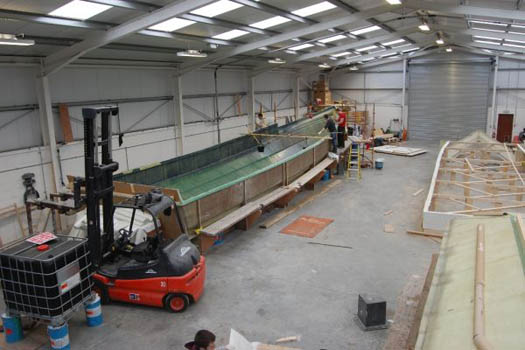
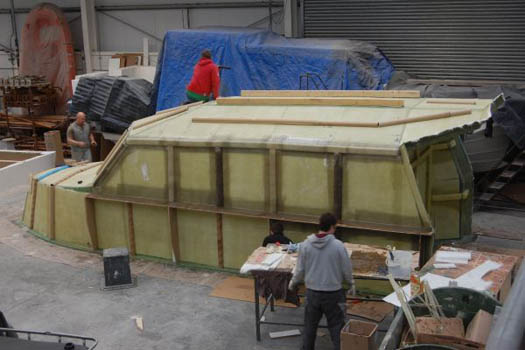
Power for the monster hull is coming from twin Volvo Penta D9 500hp engines coupled to ZF gearboxes with shafts and rudders. It is clearly a boat that will interest port companies in this country and around the world.
NZ Firm Delivers Fishery Monitoring Vessels to Alaska
#FISHING – New Zealand's Stabicraft Marine has delivered nine custom 659 Wheel House vessels to Alaska where they will be used as observation boats to monitor the gill net fishery and the fishery's interaction with sea mammals and sea birds. They look like practical boats similar in concept to Rigid inlfatables (RIBS) used in this country such as Ireland's own pioneering Red Bay Boats Cabin RIbs and also the Garda Siochana Water Unit's Delta Cabin RIBs currently deployed in Glandore Bay.
The vessel orders came at a special request from Saltwater Inc, a private organization that gathers data on wild life and fish stocks for the Alaskan Department of Fish and Game and by the National Marine Fisheries Service.
The order is a coup for New Zealand based Stabicraft Marine, as the vessels had to meet stringent US criteria. Stabicraft as a manufacturer came under intense scrutiny for being a non US company as well as having to have an independent Marine Surveyor assess Stabicraft's design - ultimately endorsing their design and build.
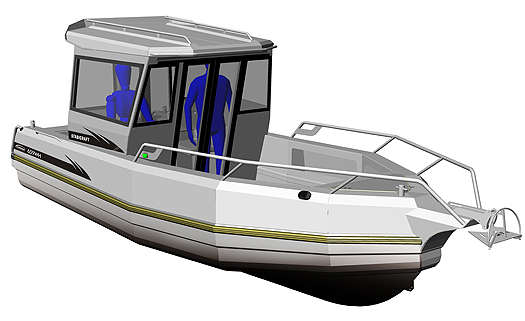
The Stabicraft 659 Wheel House destined for fishery monitoring duties in Alaska
"Saltwater, Inc. located in Anchorage, Alaska, has ordered the vessels as part of a US federal government contract with national marine fisheries. It will last for the next two summers and will be located in the Petersburg-Wrangell area of southeast Alaska," says Stabicraft Marine Managing Director, Paul Adams.
Each boat will have an operator and observer onboard, some days the vessels and their operators will need to travel a total of 80 miles in all conditions and will be observing fishing vessels in the gill net fishery.
The vessels will be used in a variety of roles, mainly based around rivers and estuaries and offshore work.
"This is a significant order for Stabicraft. It has traditionally been very difficult for non-US boat manufacturers to supply vessels to be used in government projects. Its a real coup."
"We are led to believe that this is a high profile operation and everyone in the area will be watching these boats. Even though, they will be used in the inside waters of southeast Alaska, there are many days that the wind whips the seas up and the performance of these will be tested."
Each of the nine 659 Wheel House vessels had to meet stringent design and performance requirements such as visibility, stability and strength to cope with the often treacherous water conditions of Alaska.
Like all Stabicrafts, safety is a key feature. The 659 Wheel House features continuous tubes of individually sealed flotation chambers providing a 'Life Ring' of 2276 liters (601 gallons) of buoyancy on the upper-outer extremities of the boat. With the addition of an airtight chamber between the floor and the hull, these boats are virtually unsinkable. At rest, the GII Pontoon design sits in the water, giving increased stability for when the observers are moving around the forward cockpit.
Visibility is served by 6mm toughened glass all round the aft wheelhouse, with access to the cabin itself via full-length glass sliding twin doors front and rear of the cabin. To provide extra room for passenger comfort in the cabin, the cabin itself is wider at shoulder height than the gunnels.
Extra emphasis has been placed on the gunnel height of the vessels and was designed at 873mm (34in). The Stabicraft design team incorporated high gunnels to not only keep passengers safe when out on deck, but also would see the vessel being less likely to take on water and be safer.
"Stabicrafts are already inherently very strong and the pontoon design adds a lot of rigidity. On these particular 659 Wheel House vessels, this has been enhanced by the use of 6mm plate alloy for the hull, 4mm for the pontoons and 4mm for the cabin."
"The positive buoyancy tubes offer 'life-ring' security, the Saltwater Inc observers are going to be very, very safe when out on the job.'
The 9 Stabicraft vessels will begin on water operations in the coming weeks.
Stabicraft 659 Wheel House Specifications:
Length Overall: 6893mm (22.6ft)
External Beam: 2361mm (7.7ft)
Internal Beam: 1700mm (5.5ft)
Gunnel Height: 873mm (2.8ft)
Cabin Height: 1988mm (6.5ft)
Cabin Width: 1842mm (6.0ft)
Fuel Capacity: 284litres (75 Gallons)
Vessel Weight: Approx 1100kg (2,425lbs)
Max Persons: 7
Max Persons Weight: 495kg (1092lbs)
Max Load (Persons, Motors, Gear): 958kg (2113lbs)
Motor Max Hp: 2x 150hp outboards





























